Hyperbranched Polylysine Exhibits a Collaborative Enhancement of the Antibiotic Capacity to Kill Gram-Negative Pathogens
Abstract
1. Introduction
2. Results
2.1. Characterization of Synthetic HBPL-6
2.2. Cytotoxicity and Hemolytic Toxicity of HBPL-6
2.3. Bacterial Permeability
2.4. MIC Determination and Checkerboard Synergy Test
2.4.1. MIC Values of HBPL-6
2.4.2. Synergistic Effect Analysis of HBPL-6 on Antibiotics
3. Discussion
4. Materials and Methods
4.1. Materials
4.2. Synthesis of Hyperbranched Polylysine-6h (HBPL-6)
4.3. Characterization Measurement of HBPL-6
4.4. Cytotoxicity of HBPL-6
4.5. Hemolytic Toxicity of HBPL-6
4.6. The Minimum Inhibitory Concentration of HBPL-6 on G− Bacteria
4.7. Bacterial Permeabilization of Polylysine
4.8. Membrane Integrity Effect of HBPL-6
4.9. Nucleic Acid Leakage in the Cytoplasm Treated with HBPL-6
4.10. Reactive Oxygen Species (ROS) Measurement in Bacteria
4.11. Synergistic Potentiation of HBPL-6 on Antibiotics
4.12. Scanning Electron Microscopy
4.13. Statistical Analyses
5. Conclusions
Supplementary Materials
Author Contributions
Funding
Institutional Review Board Statement
Informed Consent Statement
Data Availability Statement
Acknowledgments
Conflicts of Interest
References
- Chen, C.-H.; Chiou, Y.-C.; Yang, C.-L.; Wang, J.-H.; Chen, W.-R.; Whang, L.-M. Biosorption and biotransformation behaviours of veterinary antibiotics under aerobic livestock wastewater treatment processes. Chemosphere 2023, 335, 139034. [Google Scholar] [CrossRef] [PubMed]
- Lekshmi, M.; Ammini, P.; Kumar, S.; Varela, M.F. The Food Production Environment and the Development of Antimicrobial Resistance in Human Pathogens of Animal Origin. Microorganisms 2017, 5, 11. [Google Scholar] [CrossRef]
- Van, T.T.H.; Yidana, Z.; Smooker, P.M.; Coloe, P.J. Antibiotic use in food animals worldwide, with a focus on Africa: Pluses and minuses. J. Glob. Antimicrob. Resist. 2020, 20, 170–177. [Google Scholar] [CrossRef] [PubMed]
- Van Boeckel, T.P.; Brower, C.; Gilbert, M.; Grenfell, B.T.; Levin, S.A.; Robinson, T.P.; Teillant, A.; Laxminarayan, R. Global trends in antimicrobial use in food animals. Proc. Natl. Acad. Sci. USA 2015, 112, 5649–5654. [Google Scholar] [CrossRef] [PubMed]
- Gustafsson, A.; BÄVerud, V.; Gunnarsson, A.; Rantzien, M.H.; Lindholm, A.; Franklin, A. The association of erythromycin ethylsuccinate with acute colitis in horses in Sweden. Equine Vet. J. 1997, 29, 314–318. [Google Scholar] [CrossRef]
- Rhouma, M.; Fairbrother, J.M.; Beaudry, F.; Letellier, A. Post weaning diarrhea in pigs: Risk factors and non-colistin-based control strategies. Acta Vet. Scand. 2017, 59, 31. [Google Scholar] [CrossRef]
- Jansen, W.; van Hout, J.; Wiegel, J.; Iatridou, D.; Chantziaras, I.; De Briyne, N. Colistin Use in European Livestock: Veterinary Field Data on Trends and Perspectives for Further Reduction. Vet. Sci. 2022, 9, 650. [Google Scholar] [CrossRef]
- Catry, B.; Cavaleri, M.; Baptiste, K.; Grave, K.; Grein, K.; Holm, A.; Jukes, H.; Liebana, E.; Navas, A.L.; Mackay, D.; et al. Use of colistin-containing products within the European Union and European Economic Area (EU/EEA): Development of resistance in animals and possible impact on human and animal health. Int. J. Antimicrob. Agents 2015, 46, 297–306. [Google Scholar] [CrossRef]
- Gill, E.E.; Franco, O.L.; Hancock, R.E.W. Antibiotic Adjuvants: Diverse Strategies for Controlling Drug-Resistant Pathogens. Chem. Biol. Drug Des. 2015, 85, 56–78. [Google Scholar] [CrossRef] [PubMed]
- Saha, S.; Savage, P.B.; Bal, M. Enhancement of the efficacy of erythromycin in multiple antibiotic-resistant gram-negative bacterial pathogens. J. Appl. Microbiol. 2008, 105, 822–828. [Google Scholar] [CrossRef] [PubMed]
- Zhong, Z.-x.; Zhou, S.; Liang, Y.-j.; Wei, Y.-y.; Li, Y.; Long, T.-f.; He, Q.; Li, M.-y.; Zhou, Y.-f.; Yu, Y.; et al. Natural flavonoids disrupt bacterial iron homeostasis to potentiate colistin efficacy. Sci. Adv. 2023, 9, eadg4205. [Google Scholar] [CrossRef] [PubMed]
- Baker, K.R.; Jana, B.; Hansen, A.M.; Vissing, K.J.; Nielsen, H.M.; Franzyk, H.; Guardabassi, L. Repurposing azithromycin and rifampicin against Gram-negative pathogens by combination with peptide potentiators. Int. J. Antimicrob. Agents 2019, 53, 868–872. [Google Scholar] [CrossRef] [PubMed]
- Douafer, H.; Andrieu, V.; Phanstiel, O.I.V.; Brunel, J.M. Antibiotic Adjuvants: Make Antibiotics Great Again! J. Med. Chem. 2019, 62, 8665–8681. [Google Scholar] [CrossRef]
- Scholl, M.; Nguyen, T.Q.; Bruchmann, B.; Klok, H.-A. Controlling Polymer Architecture in the Thermal Hyperbranched Polymerization of l-Lysine. Macromolecules 2007, 40, 5726–5734. [Google Scholar] [CrossRef]
- Kadlecova, Z.; Rajendra, Y.; Matasci, M.; Baldi, L.; Hacker, D.L.; Wurm, F.M.; Klok, H.-A. DNA delivery with hyperbranched polylysine: A comparative study with linear and dendritic polylysine. J. Control. Release 2013, 169, 276–288. [Google Scholar] [CrossRef]
- Sundaran, S.; Kok, L.-C.; Chang, H.-Y. Combination effect of epsilon-poly-L-lysine and antibiotics against common bacterial pathogens. J. Antibiot. 2022, 75, 354–359. [Google Scholar] [CrossRef]
- Cezard, A.; Fouquenet, D.; Vasseur, V.; Jeannot, K.; Launay, F.; Si-Tahar, M.; Hervé, V. Poly-L-Lysine to Fight Antibiotic Resistances of Pseudomonas aeruginosa. Int. J. Mol. Sci. 2023, 24, 2851. [Google Scholar] [CrossRef]
- Stagi, L.; de Forni, D.; Innocenzi, P. Blocking viral infections with lysine-based polymeric nanostructures: A critical review. Biomater. Sci. 2022, 10, 1904–1919. [Google Scholar] [CrossRef]
- Ho, C.H.; Thiel, M.; Celik, S.; Odermatt, E.K.; Berndt, I.; Thomann, R.; Tiller, J.C. Conventional and microwave-assisted synthesis of hyperbranched and highly branched polylysine towards amphiphilic core–shell nanocontainers for metal nanoparticles. Polymer 2012, 53, 4623–4630. [Google Scholar] [CrossRef]
- Stagi, L.; De Forni, D.; Malfatti, L. Effective SARS-CoV-2 antiviral activity of hyperbranched polylysine nanopolymers. Nanoscale 2021, 13, 16465–16476. [Google Scholar] [CrossRef]
- Alazzo, A.; Lovato, T.; Collins, H.; Taresco, V.; Stolnik, S.; Soliman, M.; Spriggs, K.; Alexander, C. Structural variations in hyperbranched polymers prepared via thermal polycondensation of lysine and histidine and their effects on DNA delivery. J. Interdiscip. Nanomed. 2018, 3, 38–54. [Google Scholar] [CrossRef]
- Aydın, M.; Kartal, Z.; Osmanoğlu, Ş.; Halim Başkan, M.; Topkaya, R. EPR and FT-IR spectroscopic studies of l-lysine monohydrochloride and l-glutamic acid hydrochloride powders. J. Mol. Struct. 2011, 994, 150–154. [Google Scholar] [CrossRef]
- Shan, P.; Lu, H.; Chen, N.; Liu, H.; Zhang, X.; Liu, X. A novel bioderived AB2-type monomer from castor oil derivative for the preparation of fully biobased hyperbranched polyesters. J. Appl. Polym. Sci. 2022, 139, e52765. [Google Scholar] [CrossRef]
- Aslani, R.; Namazi, H. Simple fabrication of multifunctional hyperbranched copolymer based on l-lysine and citric acid for co-delivery of anticancer drugs to breast cancer cells. React. Funct. Polym. 2022, 170, 105101. [Google Scholar] [CrossRef]
- Fischer, D.; Li, Y.; Ahlemeyer, B.; Krieglstein, J.; Kissel, T. In vitro cytotoxicity testing of polycations: Influence of polymer structure on cell viability and hemolysis. Biomaterials 2003, 24, 1121–1131. [Google Scholar] [CrossRef] [PubMed]
- Kadlecova, Z.; Baldi, L.; Hacker, D.; Wurm, F.M.; Klok, H.-A. Comparative Study on the In Vitro Cytotoxicity of Linear, Dendritic, and Hyperbranched Polylysine Analogues. Biomacromolecules 2012, 13, 3127–3137. [Google Scholar] [CrossRef] [PubMed]
- Liu, H.; Liu, X.; Cao, Y.-Q.; Liu, M.; Han, M.-M.; Ji, S.-X. Engineering Antibacterial Activities and Biocompatibility of Hyperbranched Lysine-based Random Copolymers. Chin. J. Polym. Sci. 2023, 41, 345–355. [Google Scholar] [CrossRef]
- Shi, C.; He, Y.; Feng, X.; Fu, D. ε-Polylysine and next-generation dendrigraft poly-L-lysine: Chemistry, activity, and applications in biopharmaceuticals. J. Biomater. Sci. Polym. Ed. 2015, 26, 1343–1356. [Google Scholar] [CrossRef] [PubMed]
- Liu, H.; Pei, H.; Han, Z.; Feng, G.; Li, D. The antimicrobial effects and synergistic antibacterial mechanism of the combination of ε-Polylysine and nisin against Bacillus subtilis. Food Control 2015, 47, 444–450. [Google Scholar] [CrossRef]
- Lee, D.-S.; Je, J.-Y. Gallic Acid-Grafted-Chitosan Inhibits Foodborne Pathogens by a Membrane Damage Mechanism. J. Agric. Food Chem. 2013, 61, 6574–6579. [Google Scholar] [CrossRef] [PubMed]
- Lin, Q.-P.; Zhou, L.-F.; Li, N.-N.; Chen, Y.-Q.; Li, B.-C.; Cai, Y.-F.; Zhang, S.-Q. Lipopolysaccharide neutralization by the antibacterial peptide CM4. Eur. J. Pharmacol. 2008, 596, 160–165. [Google Scholar] [CrossRef] [PubMed]
- Johansen, C.; Verheul, A.; Gram, L.; Gill, T.; Abee, T. Protamine-induced permeabilization of cell envelopes of gram-positive and gram-negative bacteria. Appl. Environ. Microbiol. 1997, 63, 1155–1159. [Google Scholar] [CrossRef] [PubMed]
- Amato, G.; Grimaudo, M.A.; Alvarez-Lorenzo, C.; Concheiro, A.; Carbone, C.; Bonaccorso, A.; Puglisi, G.; Musumeci, T. Hyaluronan/Poly-L-lysine/Berberine Nanogels for Impaired Wound Healing. Pharmaceutics 2021, 13, 34. [Google Scholar] [CrossRef] [PubMed]
- Liu, Y.; Li, R.; Xiao, X.; Wang, Z. Antibiotic adjuvants: An alternative approach to overcome multi-drug resistant Gram-negative bacteria. Crit. Rev. Microbiol. 2019, 45, 301–314. [Google Scholar] [CrossRef]
- Lu, Y.; Tian, H.; Chen, R.; Liu, Q.; Jia, K.; Hu, D.-L.; Chen, H.; Ye, C.; Peng, L.; Fang, R. Synergistic Antimicrobial Effect of Antimicrobial Peptides CATH-1, CATH-3, and PMAP-36 With Erythromycin Against Bacterial Pathogens. Front. Microbiol. 2022, 13, 953720. [Google Scholar] [CrossRef]
- Tantisuwanno, C.; Dang, F.; Bender, K.; Spencer, J.D.; Jennings, M.E.; Barton, H.A.; Joy, A. Synergism between Rifampicin and Cationic Polyurethanes Overcomes Intrinsic Resistance of Escherichia coli. Biomacromolecules 2021, 22, 2910–2920. [Google Scholar] [CrossRef]
- Mankoci, S.; Kaiser, R.L.; Sahai, N.; Barton, H.A.; Joy, A. Bactericidal Peptidomimetic Polyurethanes with Remarkable Selectivity against Escherichia coli. ACS Biomater. Sci. Eng. 2017, 3, 2588–2597. [Google Scholar] [CrossRef]
- Zurawski Daniel, V.; Reinhart Alexandria, A.; Alamneh Yonas, A.; Pucci Michael, J.; Si, Y.; Abu-Taleb, R.; Shearer Jonathan, P.; Demons Samandra, T.; Tyner Stuart, D.; Lister, T. SPR741, an Antibiotic Adjuvant, Potentiates the In Vitro and In Vivo Activity of Rifampin against Clinically Relevant Extensively Drug-Resistant Acinetobacter baumannii. Antimicrob. Agents Chemother. 2017, 61, e01239-17. [Google Scholar] [CrossRef]
- Gorityala, B.K.; Guchhait, G.; Fernando, D.M.; Deo, S.; McKenna, S.A.; Zhanel, G.G.; Kumar, A.; Schweizer, F. Adjuvants Based on Hybrid Antibiotics Overcome Resistance in Pseudomonas aeruginosa and Enhance Fluoroquinolone Efficacy. Angew. Chem. Int. Ed. 2016, 55, 555–559. [Google Scholar] [CrossRef]
- Lyu, Y.; Yang, X.; Goswami, S.; Gorityala, B.K.; Idowu, T.; Domalaon, R.; Zhanel, G.G.; Shan, A.; Schweizer, F. Amphiphilic Tobramycin–Lysine Conjugates Sensitize Multidrug Resistant Gram-Negative Bacteria to Rifampicin and Minocycline. J. Med. Chem. 2017, 60, 3684–3702. [Google Scholar] [CrossRef]
- Schweizer, F. Enhancing uptake of antibiotics into Gram-negative bacteria using nonribosome-targeting aminoglycoside-based adjuvants. Future Med. Chem. 2019, 11, 1519–1522. [Google Scholar] [CrossRef]
- Patel, S.; Gheewala, N.; Shah, A.; Patel, S. In-Vitro cytotoxicity activity of Solanum Nigrum extract against Hela cell line and Vero cell line. Int. J. Pharm. Pharm. Sci. 2008, 1, 4786–4792. [Google Scholar]
- Dennison, S.R.; Phoenix, D.A. Susceptibility of sheep, human, and pig erythrocytes to haemolysis by the antimicrobial peptide Modelin 5. Eur. Biophys. J. 2014, 43, 423–432. [Google Scholar] [CrossRef]
- Kowalska-Krochmal, B.; Dudek-Wicher, R. The Minimum Inhibitory Concentration of Antibiotics: Methods, Interpretation, Clinical Relevance. Pathogens 2021, 10, 165. [Google Scholar] [CrossRef]
- Helander, I.M.; Mattila-Sandholm, T. Fluorometric assessment of Gram-negative bacterial permeabilization. J. Appl. Microbiol. 2000, 88, 213–219. [Google Scholar] [CrossRef] [PubMed]
- Köse, E.; Koyuncu Ozyurt, O.; Bilmen, S.; Er, H.; Kilit, C.; Aydemir, E. Quercetin: Synergistic Interaction with Antibiotics against Colistin-Resistant Acinetobacter baumannii. Antibiotics 2023, 12, 739. [Google Scholar] [CrossRef]
- Song, M.; Liu, Y.; Huang, X.; Ding, S.; Wang, Y.; Shen, J.; Zhu, K. A broad-spectrum antibiotic adjuvant reverses multidrug-resistant Gram-negative pathogens. Nat. Microbiol. 2020, 5, 1040–1050. [Google Scholar] [CrossRef]
- Zingales, V.; Fedeli, C.; Fernández-Franzón, M.; Ruiz, M.-J. Cytotoxic effects of individual and combined sterigmatocystin and nivalenol on liver hepatocellular carcinoma cells. Food Chem. Toxicol. 2020, 143, 111473. [Google Scholar] [CrossRef] [PubMed]
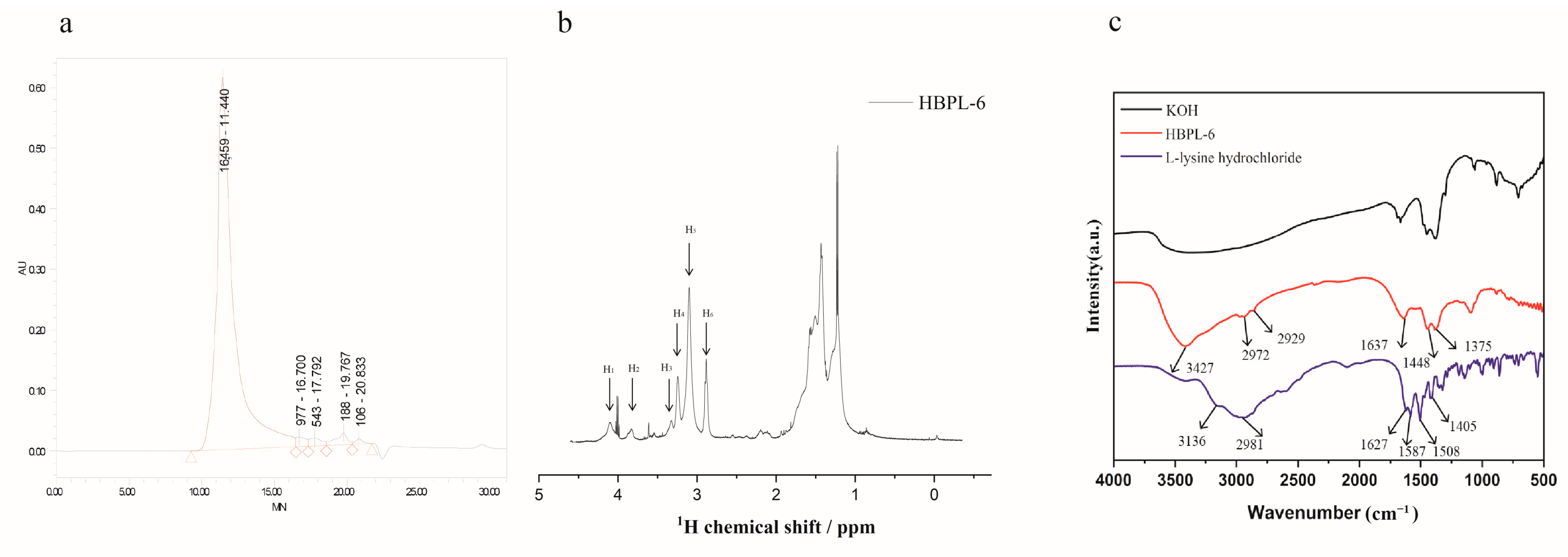


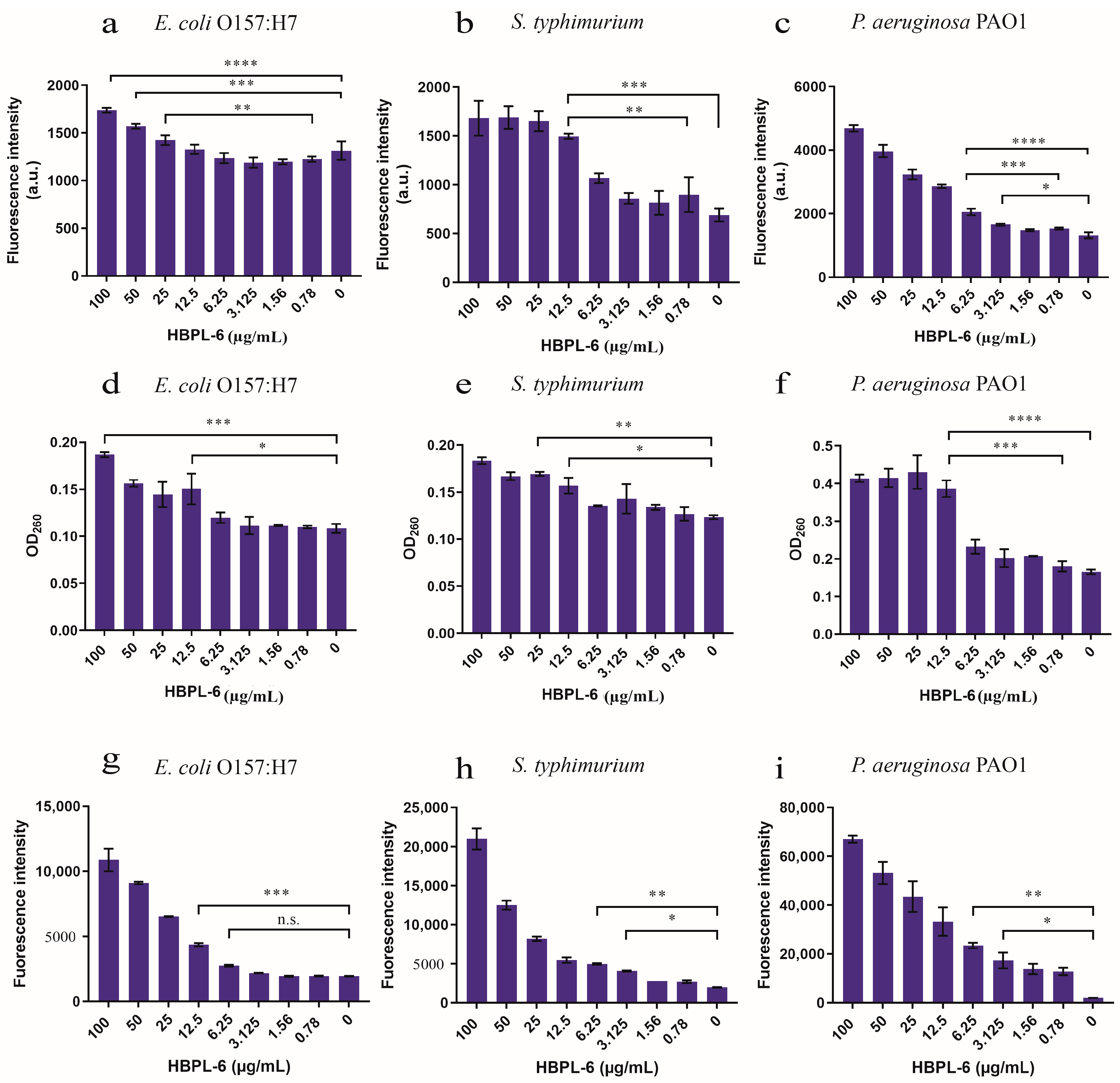

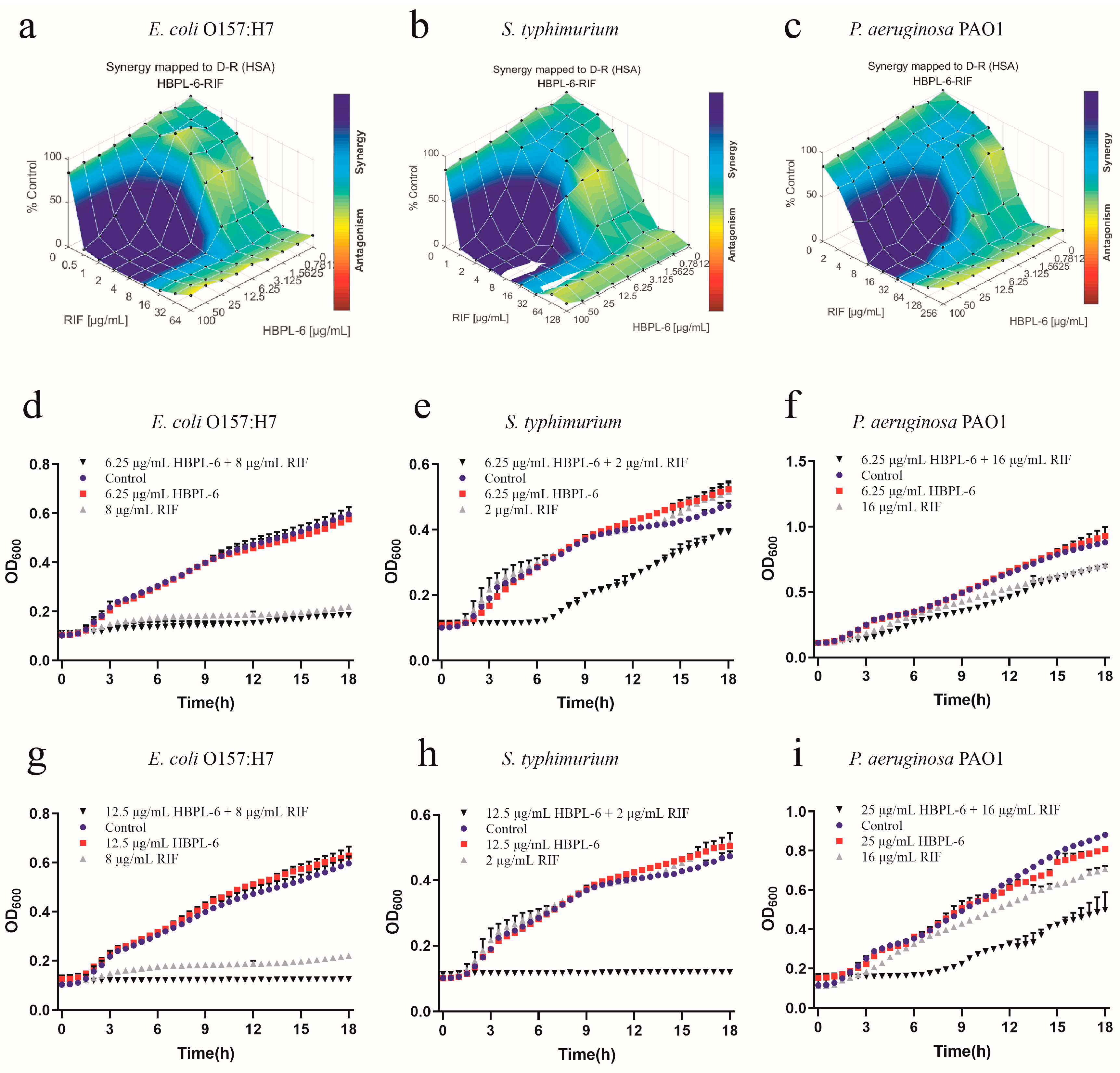
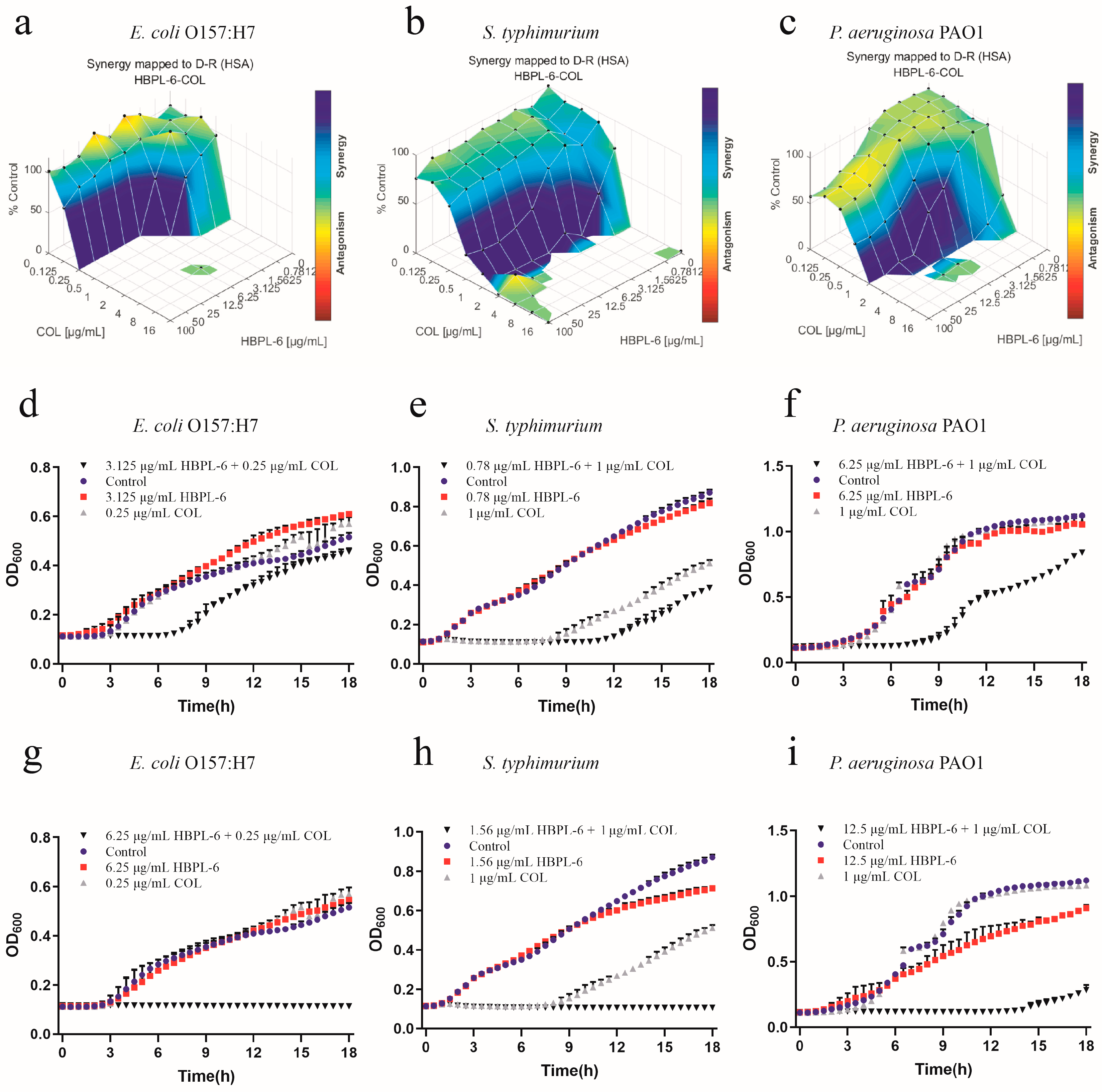
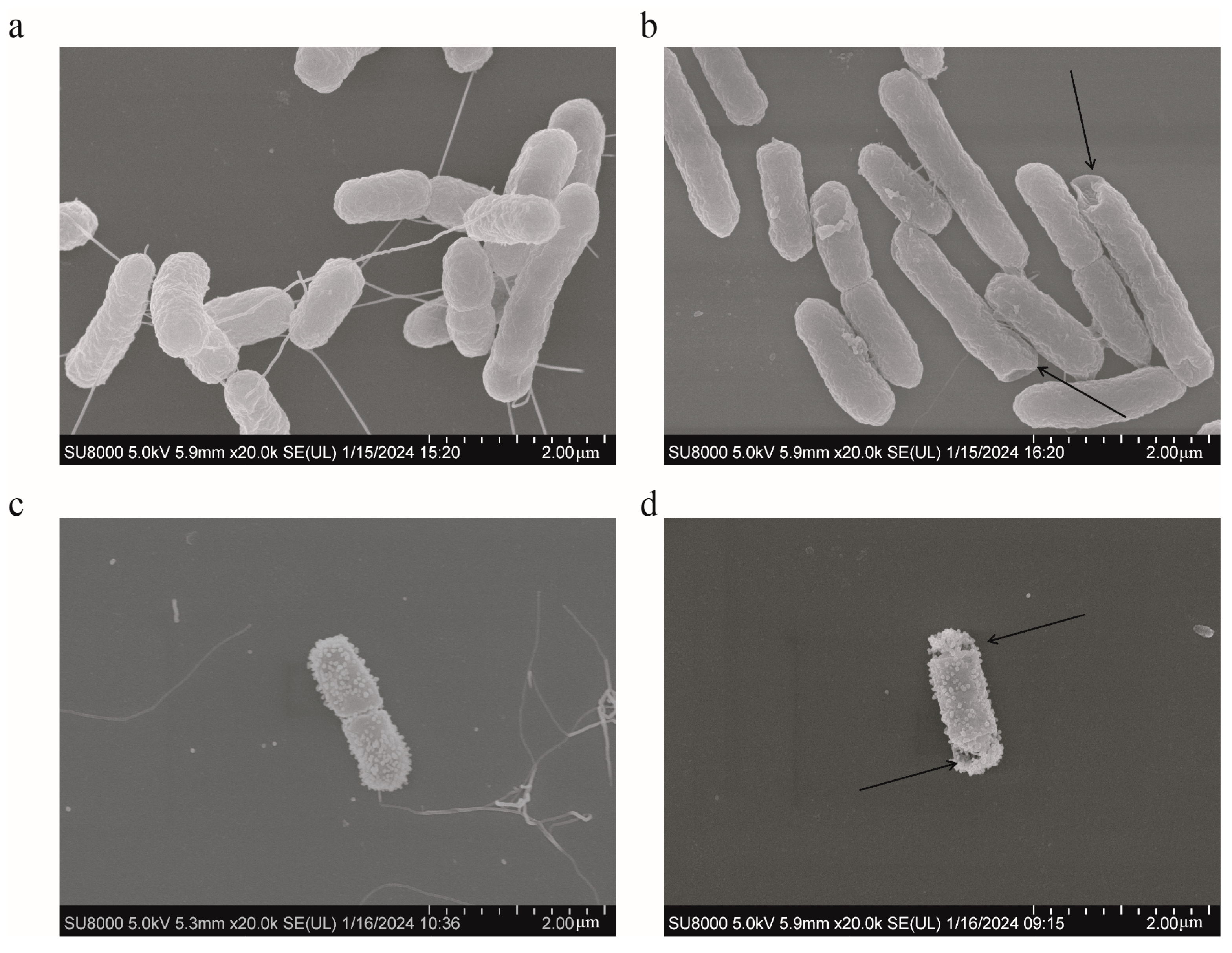
| Sample | NPN | Fluorescence Value | Subtracted Background Value | NPN Uptake Factor |
|---|---|---|---|---|
| Buffer | − | 811.1666667 | ||
| Buffer | + | 9696.666667 | 8885.50 | 1.00 |
| Cell | − | 965.5 | ||
| Cell | + | 11,842.33333 | 10,876.83 | 1.22 |
| Cell+HBPL-6 at 100 µg/mL | − | 11,786.5 | ||
| Cell+HBPL-6 at 100 µg/mL | + | 117,166.1667 | 105,379.67 | 11.86 |
| Cell+HBPL-6 at 50 µg/mL | − | 6989.833333 | ||
| Cell+HBPL-6 at 50 µg/mL | + | 112,081.8333 | 105,092.00 | 11.83 |
| Cell+HBPL-6 at 25 µg/mL | − | 4238 | ||
| Cell+HBPL-6 at 25 µg/mL | + | 85,813.83333 | 81,575.83 | 9.18 |
| Cell+HBPL-6 at 12.5 µg/mL | − | 2535.5 | ||
| Cell+HBPL-6 at 12.5 µg/mL | + | 58,615.33333 | 56,079.83 | 6.31 |
| Cell+HBPL-6 at 6.25 µg/mL | − | 1969.166667 | ||
| Cell+HBPL-6 at 6.25 µg/mL | + | 50,474.66667 | 48,505.50 | 5.46 |
| Cell+HBPL-6 at 3.125 µg/mL | − | 1350 | ||
| Cell+HBPL-6 at 3.125 µg/mL | + | 47,191.83333 | 45,841.83333 | 5.16 |
| Cell+HBPL-6 at 1.56 µg/mL | − | 1216 | ||
| Cell+HBPL-6 at 1.56 µg/mL | + | 14,067.16667 | 12,851.16667 | 1.45 |
| Cell+HBPL-6 at 0.78 µg/mL | − | 1063.666667 | ||
| Cell+HBPL-6 at 0.78 µg/mL | + | 12,175.66667 | 11,112 | 1.25 |
| Sample | NPN | Fluorescence Value | Subtracted Background Value | NPN Uptake Factor |
|---|---|---|---|---|
| Buffer | − | 779.5 | ||
| Buffer | + | 5927.666667 | 5148.17 | 1.00 |
| Cell | − | 1604.833333 | ||
| Cell | + | 8865.666667 | 7260.83 | 1.41 |
| Cell+HBPL-6 at 100 µg/mL | − | 12,767.66667 | ||
| Cell+HBPL-6 at 100 µg/mL | + | 49,625 | 36,857.33 | 7.16 |
| Cell+HBPL-6 at 50 µg/mL | − | 7674 | ||
| Cell+HBPL-6 at 50 µg/mL | + | 34,989.66667 | 27,315.67 | 5.31 |
| Cell+HBPL-6 at 25 µg/mL | − | 4776.666667 | ||
| Cell+HBPL-6 at 25 µg/mL | + | 29,421.83333 | 24,645.17 | 4.79 |
| Cell+HBPL-6 at 12.5 µg/mL | − | 3278.5 | ||
| Cell+HBPL-6 at 12.5 µg/mL | + | 25,181.33333 | 21,902.83 | 4.25 |
| Cell+HBPL-6 at 6.25 µg/mL | − | 2429.166667 | ||
| Cell+HBPL-6 at 6.25 µg/mL | + | 23,741 | 21,311.83 | 4.14 |
| Cell+HBPL-6 at 3.125 µg/mL | − | 1967.833333 | ||
| Cell+HBPL-6 at 3.125 µg/mL | + | 20,948.66667 | 18,980.83 | 3.69 |
| Cell+HBPL-6 at 1.56 µg/mL | − | 1740.166667 | ||
| Cell+HBPL-6 at 1.56 µg/mL | + | 13,686.16667 | 11,946 | 2.32 |
| Cell+HBPL-6 at 0.78 µg/mL | − | 1701.833333 | ||
| Cell+HBPL-6 at 0.78 µg/mL | + | 9985.666667 | 8283.83 | 1.61 |
| Sample | NPN | Fluorescence Value | Subtracted Background Value | NPN Uptake Factor |
|---|---|---|---|---|
| Buffer | − | 816.1666667 | ||
| Buffer | + | 9605.666667 | 8789.50 | 1.00 |
| Cell | − | 948 | ||
| Cell | + | 11,021.33333 | 10,073.33 | 1.15 |
| Cell+HBPL-6 at 100 µg/mL | − | 13,756.16667 | ||
| Cell+HBPL-6 at 100 µg/mL | + | 107,066.8333 | 93,310.67 | 10.62 |
| Cell+HBPL-6 at 50 µg/mL | − | 8544.833333 | ||
| Cell+HBPL-6 at 50 µg/mL | + | 102,247.8333 | 93,703.00 | 10.66 |
| Cell+HBPL-6 at 25 µg/mL | − | 5086 | ||
| Cell+HBPL-6 at 25 µg/mL | + | 90,774.83333 | 85,688.83 | 9.75 |
| Cell+HBPL-6 at 12.5 µg/mL | − | 3019.5 | ||
| Cell+HBPL-6 at 12.5 µg/mL | + | 80,323.66667 | 77,304.17 | 8.80 |
| Cell+HBPL-6 at 6.25 µg/mL | − | 1934.833333 | ||
| Cell+HBPL-6 at 6.25 µg/mL | + | 77,972.33333 | 53,770.83 | 6.12 |
| Cell+HBPL-6 at 3.125 µg/mL | − | 1418 | ||
| Cell+HBPL-6 at 3.125 µg/mL | + | 25,619.5 | 24,201.5 | 2.75 |
| Cell+HBPL-6 at 1.56 µg/mL | − | 1172 | ||
| Cell+HBPL-6 at 1.56 µg/mL | + | 14,529.83333 | 13,357.83333 | 1.52 |
| Cell+HBPL-6 at 0.78 µg/mL | − | 1046.666667 | ||
| Cell+HBPL-6 at 0.78 µg/mL | + | 12,893.83333 | 11,847.16667 | 1.35 |
| Microorganism | MICs of HBPL-6 (μg/mL) |
|---|---|
| Gram-negative bacteria | |
| E. coli O157:H7 | >2500 |
| S. typhimurium | >2500 |
| P. aeruginosa PAO1 | >2500 |
| Antibiotics | MICs of Antibiotics (μg/mL) | MICs of Antibiotics Supplemented with HBPL-6 (μg/mL) | FICIs * of Antibiotics |
|---|---|---|---|
| Rifampicin | 32 | 1 | 0.03125 |
| Erythromycin | 128 | 16 | 0.125 |
| Colistin | 2 | 1 | 0.5 |
| Minocycline | 4 | 2 | 0.5 |
| Tetracycline | 32 | 16 | 0.5 |
| Gentamicin | 1 | 1 | 1 |
| Neomycin | 3.75 | 3.75 | 1 |
| Tobramycin | 3.75 | 3.75 | 1 |
| Amikacin | 1.5 | 1.5 | 1 |
| Ampicillin | 2 | 2 | 1 |
Disclaimer/Publisher’s Note: The statements, opinions and data contained in all publications are solely those of the individual author(s) and contributor(s) and not of MDPI and/or the editor(s). MDPI and/or the editor(s) disclaim responsibility for any injury to people or property resulting from any ideas, methods, instructions or products referred to in the content. |
© 2024 by the authors. Licensee MDPI, Basel, Switzerland. This article is an open access article distributed under the terms and conditions of the Creative Commons Attribution (CC BY) license (https://creativecommons.org/licenses/by/4.0/).
Share and Cite
Gong, Y.; Peng, Q.; Qiao, Y.; Tian, D.; Zhang, Y.; Xiong, X.; He, M.; Xu, X.; Shi, B. Hyperbranched Polylysine Exhibits a Collaborative Enhancement of the Antibiotic Capacity to Kill Gram-Negative Pathogens. Antibiotics 2024, 13, 217. https://doi.org/10.3390/antibiotics13030217
Gong Y, Peng Q, Qiao Y, Tian D, Zhang Y, Xiong X, He M, Xu X, Shi B. Hyperbranched Polylysine Exhibits a Collaborative Enhancement of the Antibiotic Capacity to Kill Gram-Negative Pathogens. Antibiotics. 2024; 13(3):217. https://doi.org/10.3390/antibiotics13030217
Chicago/Turabian StyleGong, Yuxin, Qing Peng, Yu Qiao, Dandan Tian, Yuwei Zhang, Xiaoyan Xiong, Mengxin He, Xiaoqing Xu, and Bo Shi. 2024. "Hyperbranched Polylysine Exhibits a Collaborative Enhancement of the Antibiotic Capacity to Kill Gram-Negative Pathogens" Antibiotics 13, no. 3: 217. https://doi.org/10.3390/antibiotics13030217
APA StyleGong, Y., Peng, Q., Qiao, Y., Tian, D., Zhang, Y., Xiong, X., He, M., Xu, X., & Shi, B. (2024). Hyperbranched Polylysine Exhibits a Collaborative Enhancement of the Antibiotic Capacity to Kill Gram-Negative Pathogens. Antibiotics, 13(3), 217. https://doi.org/10.3390/antibiotics13030217






